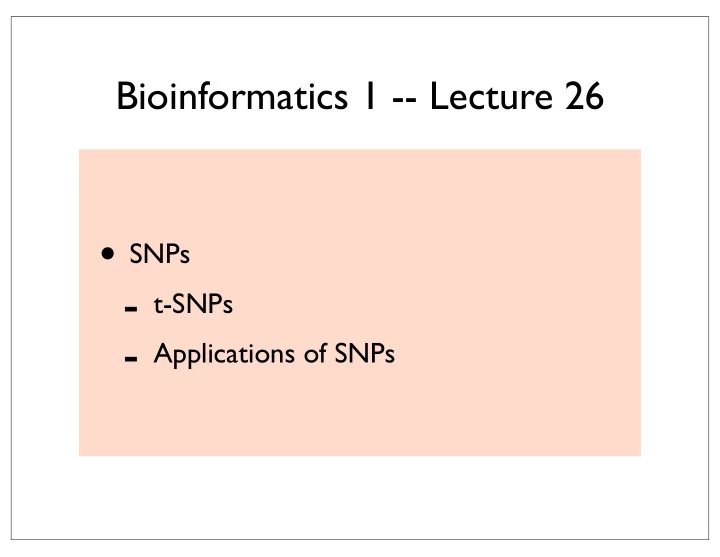

Bioinformatics 1 -- Lecture 26 • SNPs - t-SNPs - Applications of SNPs
SNPs = single nucleotide polymorphisms What are polymorphisms? • Genetic differences between individuals in a population. • Changes related to alleles. • Single nucleotide polymorphisms (one base substitution) • Noncoding • Coding • synonymous -- same amino acid, different codon • non-synonymous • missense -- change in amino acid • nonsense -- stop codon • Frame-shifts • One or more base Insertion/deletion
NCBI : SNP database How To: View all SNPs associated with a gene Starting with... a gene name 1. Search the Gene database with the gene name. If you know the gene symbol and species, enter them as follows: tpo[sym] AND human[orgn] 2. Click on the desired gene. 3. In the list of Links on the right, click "SNP:GeneView". If the link is not present, no SNPs are currently linked to this gene. a nucleotide or protein accession number (e.g. NM_001126) 1. Search the Nucleotide or Protein database with the accession number. 2. In the Links menu in the upper right, click on "GeneView in dbSNP". If the link is not present, click on the "Gene" link in the same menu and continue at step 3 above under "a gene name". a nucleotide sequence 1. Go to the BLAST home page and click "nucleotide blast" under Basic BLAST. 2. Paste the sequence in the query box. 3. Enter the name of the organism of interest in the "Organism" box. Click the BLAST button. 4. Click on the desired sequence from the results. 5. Continue at step 2 under "a nucleotide or protein accession number" above. a protein sequence 1. Go to the BLAST home page and click "protein blast" under Basic BLAST. 2. Paste the sequence in the query box. 3. Enter the name of the organism of interest in the "Organism" box. Click the BLAST button. 4. Click on the desired sequence from the results. 5. Continue at step 2 under " a nucleotide or protein accession number " above.
GeneView page from dbSNP link Goes to chromosome 6 navigator window.
Tagging SNPs, tSNPs • SNPs that are highly correlated are redundant information • tSNPs are selected as the minimal non-redundant set of SNPs in a population, such that the genotypes can be reconstructed from the tSNPs. • tSNPs allow genotyping with fewer steps – PCR amplification experiments determine which base is present. • Block based tagging Block based tagging requires that hapltype "blocks" first be infered. In the majority of cases when you are investigating association within a candidate gene you are likely to start of with a large number of potential SNPs to choose from, and using various measures of linkage disequilibrium and inferred haplotypes it is possible to define 'haplotype blocks' of markers that are in strong LD with each other, but not with those in other blocks. The exact definition of a haplotype block is open to interpretation, and there are a number of different methods for choosing your haplotype blocks (Gabriel et al 2002, ) 5
Individual allele 6
Uses of SNPs • Personalized medicine –Sensitivity to –diseases –drugs –chemicals –pathogens –vaccines • Livestock breeding • Human migrations 7
Recommend
More recommend